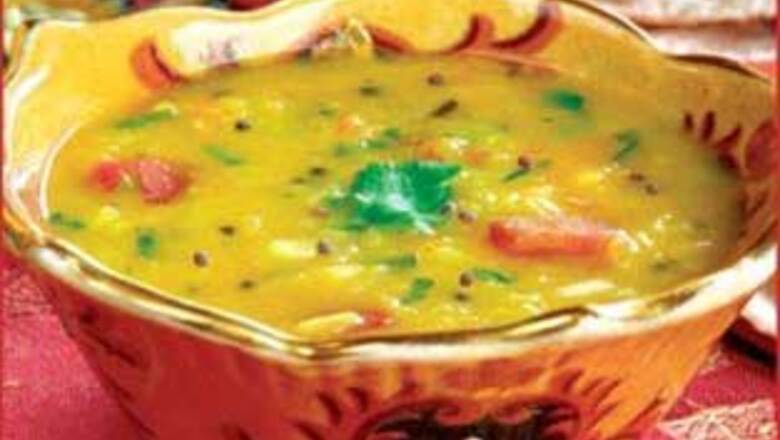
views
For decades, dal has been a staple dish in our family. It's a breeze to make, and everyone loves its mild curry flavors and feels satisfied after eating it.
A cornerstone of Vedic cooking, dal has been a major component of most meals in India for countless centuries. Literally translated, dal simply means "seed." As a dish, however, it's usually comprised of small legumes called pulses, such as lentils or mung beans. Technically seeds themselves, pulses cook relatively quickly and go well with most grains and veggies.
The Different Dals
Lentils and mung beans come in many shapes, sizes, colors, and textures. Like all beans, they are packed with a balance of quality nutrition such as protein, complex carbohydrates, fiber, calcium, and B vitamins. They make for a nurturing, satiating, and sustaining meal, especially when cooked or served with vegetables and partnered with basmati rice or whole-wheat chapatis (tortilla-like Indian flatbreads).
Of all dal varieties, yellow mung dal is most highly regarded by Ayurvedic practitioners because it requires no pre-soaking, cooks quickly, is easy to digest, and is suitable for all body types, even children and the elderly. Yellow mung dal generally does not cause any gas or bloating—a common complaint with larger beans. It also has a palatable nutty flavor.
Split red lentils, otherwise known as masoor, also cook quickly and digest easily. After simmering for 20 minutes or so, both yellow mung dal and red lentils lose their form, disintegrating to create a rich, creamy texture for delicious, satisfying soups. In cookbooks and on many restaurant menus, you'll find such soups simply referred to as dal.
Brown and green lentils, on the other hand, keep their form during cooking. These pulses are a little
harder to digest—though far easier than the bigger kidney or pinto beans!
Lentils make fine simple dishes on their own, along with some spices and a vegetable or two. They also make hearty additions to soups and stews. Lentils are even good cooked with brown rice, which takes about the same amount of time to cook. There is no need to pre-soak brown or green lentils.
Dal is also commonly made of channa, or split hulled black chickpeas, which take longer to cook and are not as easy to digest. Channa should be pre-soaked for a day before preparation and cooked for about two hours. A pressure cooker reduces cook time to mere minutes.
PAGE_BREAK
You can find most lentils, mung beans, and channa in Indian stores, health-food stores, bulk stores, and even some supermarkets. Store all varieties in airtight containers and try to use them within three months of purchase. The older they get, the tougher they get, so you'll need to soak and cook them longer as they age. Prior to preparation, be sure to sift pulses to remove any pebbles or other debris, then rinse them thoroughly.
Improving Digestibility
Generally speaking, the smaller the bean, the easier it is to digest. This is why yellow mung dal and
red lentils are ideal. To increase the digestibility of any legume, however, cook with spices like coriander, cumin, turmeric, ginger, fennel, clove, and cayenne.
Whenever required, soak legumes for the appropriate amount of time (between one and 24 hours, depending on the size, age, and toughness of the bean). Always discard the soaking water and cook beans in fresh water. Skim the foam off the water's surface during cooking to further reduce any gas-producing properties. Don't salt the beans until after they've cooked as salt causes them to toughen up, thus prolonging the cook time.
Easy Dal
Beautifully flavored, low in fat, and rich in protein, this tasty dal is easy to make and delightful to eat. Try making it as a palate-whetting appetizer or as a delicious meal in itself along with fragrant basmati rice.
INGREDIENTS
21⁄2 cups dried red lentils, sifted and rinsed well
7 cups water
One 15-ounce can diced tomatoes (or 2 cups fresh)
11⁄2 tablespoons minced ginger
1⁄4 teaspoon turmeric
1 teaspoon olive oil or ghee
1 teaspoon cumin seeds
1 teaspoon black mustard seeds
1⁄4 teaspoon minced fresh chili or red chili flakes
1 teaspoon ground coriander
21⁄4 teaspoons salt, or to taste
1⁄2 cup minced cilantro or mint leaves,
plus extra for garnishing
1⁄2 tablespoon minced garlic
PROCEDURE
1. Place the lentils, water, tomato, ginger, and turmeric in a 4-quart pot over high heat. Bring to a boil, reduce the heat to medium, cover, and simmer for about 30 minutes.
2. When the lentils have broken down and the soup is quite smooth, heat the ghee or oil in a small skillet over high heat. Add the cumin and mustard seeds, and sauté for a few seconds. When the cumin darkens, add the chili and coriander, and stir for a few seconds. Remove from the heat, and add immediately to the soup along with the salt.
3. Add the cilantro or mint leaves and garlic, and stir through. Ladle into bowls, garnish with extra cilantro or mint, and serve.
TIPS/VARIATIONS
Veggie variation: Include 1 to 2 cups chopped yam from the very beginning. Or, after the lentils have cooked for about 20 minutes, add 2 cups chopped vegetables, like broccoli, cauliflower, or spinach. Increase the water and salt, if necessary.
Coconut variation: Add 1 cup coconut milk a few minutes before serving and increase the salt slightly, if necessary.
Hands-on prep time: 10 minutes
Cook time: 40 minutes
Makes about 9 cups
The author hosts the long-running TV series Wai Lana Yoga, which airs nationally on PBS. She is the author of Wai Lana’s Favorite Juices and the upcoming Wai Lana’s Favorite Soups. For more information, please visit www.wailana.com. This feature has been sourced with permission from www.fityoga.com
















Comments
0 comment